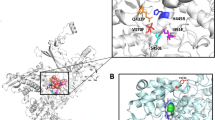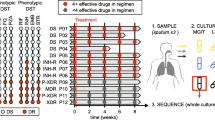Summary
Antibiotic resistance is a dominant theme in tuberculosis research. Quantitative studies on microbial mutation rates play a key role in drug resistance research. Despite recent rapid advances in whole-genome sequencing, the classic Luria-Delbrük fluctuation test continues to be the choice of method for measuring microbial mutation rates. To help researchers new to this field, the author of this chapter provides detailed descriptions and practical guidelines pertaining to the proper use of this classic protocol. The discussion focuses on practical issues that are still bewildering to many tuberculosis researchers. Future developments in the field are discussed from a personal perspective.
Graphical Abstract

Anybody can do it – after he has been shown how.
Christopher Columbus, as retold by James Baldwin
Access this chapter
Tax calculation will be finalised at checkout
Purchases are for personal use only
Similar content being viewed by others
References
Luria SE, Delbrück M (1943) Mutations of bacteria from virus sensitivity to virus resistance. Genetics 28:491–511
Luria SE (1984) A slot machine, a broken test tube: an autobiography. Harper & Row, New York
Zheng Q (2017) Toward a unique definition of the mutation rate. Bull Math Biol 79:683–692
David HL (1970) Probability distribution of drug-resistant mutants in unselected populations of Mycobacterium tuberculosis. Appl Microbiol 20:810–814
Werngren J, Hoffner SE (2003) Drug-susceptible Mycobacterium tuberculosis Bei**g genotype does not develop mutation-conferred resistance to rifampin at an elevated rate. J Clin Microbiol 41:1520–1524
Ford CB, Shah RR, Meeda MK et al (2013) Mycobacterium tuberculosis mutation rate estimates from different lineages predict substantial differences in the emergence of drug-resistant tuberculosis. Nat Genet 45:784–790
Zheng Q, Werngren J (2018) An unbiased attitude is vital to exploring the Bei**g genotype of Mycobacterium tuberculosis. Tuberculosis 111:193–197
Zheng Q (2003) Mathematical issues arising from the directed mutation controversy. Genetics 164:373–379
Chakraborty S, Rhee KY (2015) Tuberculosis drug development: history and evolution of the mechanism-based paradigm. Cold Spring Harb Perspect Med 5:a021147
Pyle M (1947) Relative numbers of resistant tubercle bacilli in sputa of patients before and during treatment with streptomycin. Proc Staff Meet Mayo Clin 22:465–473
Vennesland K, Ebert RH, Bloch RG (1947) The demonstration of naturally-occurring streptomycin-resistant variants in the human strain of tubercle bacillus H-37RV. Science 106:476–477
Yegian D, Vanderlinde RJ (1948) A quantitative analysis of the resistance of Mycobacteria to streptomycin. J Bacteriol 56:177–186
Kohanski MA, DePristo MA, Collins JJ (2010) Sublethal antibiotic treatment leads to multidrug resistance via radical-induced mutagenesis. Mol Cell 37:311–320
Henderson-Begg SK, Sheppard CL, George RC, Livermore DM, Hall LMC (2010) Mutant frequency in antibiotic-resistant and -susceptible isolates of Streptococcus pneumoniae. Int J Antimicrob Agents 35:342–346
Kayigire XA, Friedrich SO, van der Merwe L, Diacon AH (2017) Acquisition of rifampin resistance in pulmonary tuberculosis. Antimicrob Agents Chemother 61:e02220-16
Delbrück M (1945) Spontaneous mutations of bacteria. Ann Mo Bot Garden 32:223–233
de Steenwinkel JEM, ten Kate MT, de Knegt GJ, Kremer K, Aarnoutse RE, Boeree MJ, Verbrugh HA, van Soolingen D, Bakker-Woudenberg IAJM (2012) Drug susceptibility of Mycobacterium tuberculosis Bei**g genotype and association with MDR TB. Emerg Infect Dis 18:660–663
den Hertog AL, Menting S, van Soolingen D, Anthony RM (2014) Letter to the editor: Mycobacterium tuberculosis Bei**g genotype resistance to transient rifampin exposure. Emerg Infect Dis 20:1932–1933
Werngren J (2013) Letter to the editor: Mycobacterium tuberculosis Bei**g type mutation frequency. Emerg Infect Dis 19:522
Zheng Q (2018) A cautionary note on the mutation frequency in microbial research. Mutat Res 809:51–55
Parkinson JS (2016) Look, Max—no math required! J Bacteriol 17:2281–2282
Foster PL (2006) Methods for determining spontaneous mutation rates. Methods Enzymol 409:195–213
Foster PL (2007) Measuring spontaneous mutation rates. In: Reddy C, Beveridge T, Breznak J, Marzluf G, Schmidt T, Snyder L (eds) Methods for general and molecular microbiology, 3rd edn. ASM Press, Washington, DC, pp 676–683
Rosche WA, Foster PL (2000) Determining mutation rates in bacterial populations. Methods 20:4–17
Armitage P (1952) The statistical theory of bacterial population subject to mutation. J R Stat Soc Ser B 14:1–44
Armitage P (1953) Statistical concepts in the theory of bacterial mutation. J Hygiene 51:162–184
Drake JW (1970) The molecular basis of mutation. Holden-Day, San Francisco
Hayes W (1968) The genetics of bacteria and their viruses: studies in basic genetics and molecular biology, 2nd edn. Wiley, New York
Kondo S (1972) A theoretical study on spontaneous mutation rate. Mutat Res 14:365–374
Zheng Q (2005) Update on estimation of mutation rates using data from fluctuation experiments. Genetics 171:861–864
Zheng Q (2015) A new practical guide to the Luria-Delbrück protocol. Mutat Res 781:7–13
Lea EA, Coulson CA (1949) The distribution of the numbers of mutants in bacterial populations. J Genet 49:264–285
Gillespie SH, Voelker LL, Ambler JE et al (2003) Fluoroquinolone resistance in Streptococcus pneumoniae: evidence that gyrA mutations arise at a lower rate and that mutation in gyrA or parC predisposes to further mutation. Microb Drug Resist 9:17–24
Gillespie SH, Basu A, Dickens AL et al (2005) Effect of subinhibitory concentration of ciprofloxacin on Mycobacterium fortuitum mutation rates. J Antimicrob Chemother 56:344–348
Pope CF, Gillespie SH, Moore JE, McHugh TD (2010) Approaches to measure the fitness of Burkholderia cepacia complex isolates. J Med Microbiol 59:679–689
Sarkar A (1991) Haldane’s solution of the Luria-Delbrück distribution. Genetics 127:257–261
Polleys EJ, Freudenreich CH (2020) Genetic assays to study repeat fragility in Saccharomyces cerevisiae. In: Guy-Frank Richard (ed) Trinucleotide repeats: methods and protocols, methods in molecular biology, vol 2056. Springer, pp 83–101 (Chapter 5)
Stephenson FH (2016) Calculations for molecular biology and biotechnology: a guide to mathematics in the laboratory, 3rd edn. Academic, San Diego, CA
Stewart FM, Gordon DM, Levin BR (1990) Fluctuation analysis: the probability distribution of the number of mutants under different conditions. Genetics 124:175–185
Jones ME, Thomas SM, Rogers A (1994) Luria-Delbrück fluctuation experiments: design and analysis. Genetics 136:1209–1216
Stewart FM (1991) Fluctuation analysis: the effect of plating efficiency. Genetica 84:51–55
Zheng Q (2008) A note on plating efficiency in fluctuation experiments. Math Biosci 216:150–153
Ma WT, Vh Sandri G, Sarkar S (1992) Analysis of the Luria and Delbrück distribution using discrete convolution powers. J Appl Prob 29:255–267
Gurland J (1958) A generalized class of contagious distribution. Biometrics 14:229–249
Fichtenholtz GM (1954) Differential and integral calculus, Chinese language edition. Higher Education Press, Bei**g (8th edition 2006)
Fichtenholtz GM (1954) Differential- und Integralrechnung. Band 2. VEB Deutscher Verlag der Wissenschaften, Berlin (10th edition 1964, 1990)
Stewart FM (1994) Fluctuation tests: how reliable are the estimates of mutation rates? Genetics 137:1139–1146
Nádas A, Goncharova EI, Rossman TG (1996) Mutations and infinity: improved statistical methods for estimating spontaneous rates. Environ Mol Mutagen 28:90–99
Zheng Q (1999) Progress of a half century in the study of the Luria-Delbrück distribution. Math Biosci 162:1–32
Zheng Q (2017) rSalvador: an R package for the fluctuation experiment. G3 (Bethesda) 7:3849–3856
Demerec M (1945) Production of Staphylococcus strains resistant to various concentrations of penicillin. Proc Natl Acad Sci USA 31:16–24
Zheng Q (2005) New algorithms for Luria-Delbrück fluctuation analysis. Math Biosci 196:198–214
Pawitan Y (2001) In all likelihood: statistical modeling and inference using likelihood. Clarendon Press, Oxford
Zheng Q (2002) Statistical and algorithmic methods for fluctuation analysis with SALVADOR as an implementation. Math Biosci 176:237–252
Zheng Q (2016) Comparing mutation rates under the Luria-Delbrück protocol. Genetica 144:351–359
Lindsey JK (1996) Parametric statistical inference. Clarendon Press, Oxford
Agresti A (2007) An introduction to categorical data analysis, 2nd edn. Wiley, Hoboken, NJ
Zheng Q (2021) New approaches to mutation rate fold change in Luria-Delbrück fluctuation experiments. Math Biosci 335:108572
Wierdl M, Greens CN, Datta A et al (1996) Destabilization of simple repetitive DNA sequences by transcription in yeast. Genetics 143:713–721
Schmidt KH, Pennaneach V, Putamn CD, Kolodner RD (2006) Analysis of gross-chromosomal rearrangements in Saccharomyces cerevisiae. Methods Enzymol 409:462–476
Wu X, Strome ED, Meng Q et al (2009) A robust estimator of mutation rates. Mutat Res 661:101–109
Zheng Q (2011) A Bayesian two-level model for fluctuation assay. Genetica 139:1409–1416
Ycart B, Veziris N (2014) Unbiased estimation of mutation rates under fluctuating final counts. PLoS ONE 9(7):e101434
Zheng Q (2016) A second look at the final number of cells in a fluctuation experiment. J Theor Biol 401:54–63
Hamon A, Ycart B (2012) Statistics for the Luria-Delbrück distribution. Electron J Stat 6:1251–1272
Mazoyer A, Drouilhet R, Despréaux S, Ycart B (2017) flan: an R package for inference on mutation models. R J 9:334–351
Hall BM, Ma C-X, Liang P, Singh KK (2009) Fluctuation AnaLysis CalculatOR: a web tool for the determination of mutation rate using Luria-Delbrück fluctuation analysis. Bioinformatics 25:1564–1565
Nyinoh IW, McFadden J (2019) Spontaneous mutations conferring antibiotic resistance to antitubercular drugs at a range of concentrations in Mycobacterium smegmatis. Drug Dev Res 80:147–154
Radchenko EA, McCinty RJ, Aksenova AY, Neil AJ, Mirkin SM (2018) Quantitative analysis of the rates of repeat-mediated genome instability in a yeast experimental system. In: Muzi-Falconi M, Brown GW (eds) Genome instability: methods and protocols, methods in molecular biology, vol 1672. Springer, pp 421–438 (Chapter 29)
Zheng Q (2021) webSalvador: a web tool for the Luria-Delbrück experiment. Microbiol Resource Announc 10:e00314-21
Ramiro RS, Durão P, Bank C, Gordo I (2020) Low mutational load and high mutation rate variation in gut commensal bacterial. PLoS Biol 18(3):e000617
Zheng Q (2015) Methods for comparing mutation rates using fluctuation assay data. Mutat Res 777:20–22
Gillet-Markowska A, Louvel G, Fischer G (2015) bz-rates: a web-tool to estimate mutation rates from fluctuation analysis. G3 (Bethesda) 5:2323–2327
Zheng Q (2005) SALVADOR 2.0: a tool for fluctuation analysis. https://library.wolfram.com/infocenter/MathSource/5556. Accessed 22 Feb 2022
Wolfram Research, Inc. (2020) Mathematica, version 12.1. Champaign, IL
Bergval IL, Schuiteme ARJ, Klatser PR, Anthony RM (2009) Resistant mutants of Mycobacterium tuberculosis selected in vitro do not reflect the in vivo mechanism of isoniazid resistance. J Antimicrob Chemother 64:515–523
Ford CB, Lin PL, Chase MR et al (2011) Use of whole genome sequencing to estimate the mutation rate of Mycobacterium tuberculosis during latent infection. Nat Genet 43:482–486
Pauly MD, Procario MC, Lauring AS (2017) A novel twelve class fluctuation test reveals higher than expected mutation rates for influenza A viruses. eLife 6:e26437
Altmann A, Weber P, Bader D et al (2012) A beginners guide to SNP calling from high-throughput DNA-sequencing data. Hum Genet 131:1541–1554
Hwang S, Kim E, Lee I, Marcotte EM (2015) Systematic comparison of variant calling pipelines using gold standard personal exome variants. Sci Rep 5:17875
Author information
Authors and Affiliations
Corresponding author
Editor information
Editors and Affiliations
Rights and permissions
Copyright information
© 2023 The Author(s), under exclusive license to Springer Nature Switzerland AG
About this chapter
Cite this chapter
Zheng, Q. (2023). Estimation of Microbial Mutation Rates in Tuberculosis Research. In: Rezaei, N. (eds) Tuberculosis. Integrated Science, vol 11. Springer, Cham. https://doi.org/10.1007/978-3-031-15955-8_43
Download citation
DOI: https://doi.org/10.1007/978-3-031-15955-8_43
Published:
Publisher Name: Springer, Cham
Print ISBN: 978-3-031-15954-1
Online ISBN: 978-3-031-15955-8
eBook Packages: Biomedical and Life SciencesBiomedical and Life Sciences (R0)




